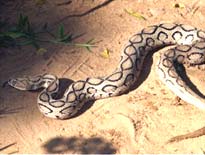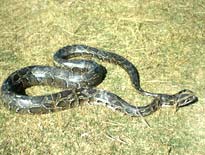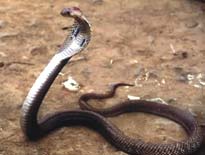Rattlesnakes belong to a genus named Crotalus a genus consisting of numerous subspecies. The name rattlesnakes of course has its origin in the rattle at the tip of their tails. The rattle is primarily used as a warning device when threatened.
Envenomations from rattlesnakes account for a significant portion of all poisonings in North America (Schaper et al., 2004)1.
Even in Europe the number of rattlesnake bites increases due to more and more people having rattlesnakes in their homes as pets (ibid).
Rattlesnake Bites
The purpose of the rattlesnake bite is to stun or to put an immediate end to its prey. If a potential prey escapes a bite a rattlesnake will hunt it down and eventually swallow it. Usually the snake is helped by its prey gradually weakening due to the toxicity of its venom.
Rattlesnakes are capable of regulating the amount of venom they inject when biting. If the rattlesnake only feels threatened it may not deliver a full dose of venom into the perceived attacker. However, a frightened or injured snake may not be able to, or in the mood to, exercise such a control. The same goes with young, inexperienced rattlesnakes.
If you are bitten by a rattlesnake you should seek medical attention immediately.
Bites on humans usually occur when the snake is provoked or disturbed. One should not underestimate the range and speed of rattlesnakes, which when coiled are much faster than most people believe. They can also strike without coiling first. If you are hiking in known rattlesnake land you should consider wearing long pants reinforced with leather. If you encounter a rattlesnake on a trail keep distance and allow the snake to escape - and keep pets away from the snake.
Rattlesnakes feed on almost any kind of small animals, from rodents to other snakes, small lizards, frogs, and birds.
Life Cycle
Rattlesnakes give live birth and the female even looks after their newborns several days (1-1½ week) after birth.
Rattlesnake Venom
Most species have hemotoxic venom, which works quickly by degenerating tissue and preventing blood from clotting. The venom in itself might not be as toxic as the venom of other snakes, but with the amount of venom the rattlesnake is capable of injecting it becomes extremely dangerous.
Loss of limbs or permanent scarring are some of the consequences of rattlesnake bites if not death. Around 0.5 percent of people receiving a bite from a rattlesnake will die, even when antivenom is applied. A normal Diamondback rattlesnake contains enough venom to cause the end of more than 50 people.
Some tropical species have neurotoxic venom. Prey or people bit by these tropical rattlesnakes will usually die from suffocation due to malfunctioning of either lungs or the circulatory system.
The rattle
The rattle of rattlesnakes is composed of modified scales from the tail. A new segment is added to the rattle every time it sheds it skins, so if the rattle couldn't break, one would be able to determine the age of the snake by looking at the numbers of segment on the rattle. A rough estimate of the age of the rattlesnake is however obtained by merely counting the segments on the rattle. The rattlesnake sheds its skin when it has grown large enough and this will also depend on prey availability, weather conditions etc. Under wet conditions the rattle won't make any noise and newborn rattlesnake can't make a noise with their rattle.
Mojave Rattlesnake
In general rattlesnakes aren't aggressive. There is one, however, the Mojave Rattlesnake that might seem a little aggressive towards humans. It is an extremely dangerous snake. It is larger than most other rattlesnakes ranging from 20 to 50 inches (0.5-1.3 m). Its coloration varies from olive green to yellow green, while its back is lined with some dark grey diamond shaped markings resembling the ones seen in the diamondback rattlesnake. The tail of the Mojave is light grey to white with very short black bands. Its preferred habitat are flat areas of the desert and land with plentiful of shrubs. The Mojave forages during the night and prefers small mammals like mice and rats.
Diamondback Rattlesnake
The Diamondback Rattlesnake is a large rattlesnake (30-84 inches) known from its diamond like gray blotches on its back and side. Its base color is a brown or gray color and its tail has alternating white and black rings. It prefers areas with rocks and shrubs. It feeds on any kind of animals, even eating animals as large as rabbits. They tend to stand their ground when provoked and are both dangerous and venomous. It gives live birth (eggs hatches inside the female body) to small diamondback rattlesnakes with a length of approximately 8-12 inches. They can be found in most western parts of the United States.
Sidewinder Rattlesnake
One of the smallest rattlesnakes ranging in size from 25 to 40 inches (0.6-1 m), it prefers to live in sandy or loamy soil and sand. It tends to hide in the shade of bushes during daytime. A dark stripe is seen from its eyes and the coloring of the body is brownish or grayish. It primarily feeds on small rodents and lizards.









